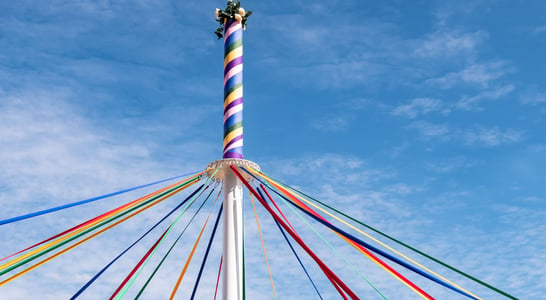
Mardi Gras
Let the good times roll with Mardi Gras! This carnival season is a time for revelry, music, and colorful celebrations. So don your beads, masks, and feathers, and join in the fun of this festive occasion!
Mardi Gras, carnaval, carnival—this fun and colorful festivity has many names depending on which country it’s celebrated.
Originally a Christian holiday, it has now turned into an annual popular cultural event in which people gather to feast, dress up in extravagant and colorful outfits, and dance to their heart’s content.
Even though Mardi Gras is a worldwide phenomenon and some countries practice this tradition to a certain extent, the best known celebrations take place in New Orleans, US, Venice, Italy, and Rio de Janeiro, Brazil, attracting millions of tourists every year.
How to Celebrate Mardi Gras
While Mardi Gras may have started out as a religious tradition, it has turned into something much bigger than that and can definitely be enjoyed by everyone looking to have fun.
Since the idea of Mardi Gras is to indulge in food and dance until hearts and stomachs are full, one of the best ways to celebrate this date is to decorate houses, wear colorful clothes, make traditional dishes and, if possible, join in the local festivities and participate in parades.
It’s not mandatory to wear a costume or mask! There’s also the possibility to travel to one of the countries that are famous for the Mardi Gras celebrations, which can turn out to be a one-of-a-kind experience not to be missed.
Host a Pancake Feast
Gather friends and family for a delightful pancake meal. Stack fluffy pancakes high, and offer toppings like fresh fruits, whipped cream, and syrup. This tradition is a tasty nod to using rich ingredients before the Lenten season.
Bake a King Cake
Try your hand at baking a traditional King Cake. This colorful, ring-shaped pastry, often adorned with purple, green, and gold sugar, adds a festive touch to any gathering. Hiding a small figurine inside adds an element of surprise for guests.
Enjoy Live Music
Immerse yourself in the sounds of jazz or zydeco music. Attend a local concert, hire a band, or create a playlist featuring these lively genres. Music sets the tone for a spirited celebration.
Create Festive Masks
Set up a crafting station with materials like feathers, sequins, and glitter. Designing personalized masks allows everyone to embrace the festive spirit and adds a creative flair to the festivities.
Prepare Cajun Dishes
Cook up classic Cajun or Creole recipes such as gumbo, jambalaya, or shrimp étouffée. These flavorful dishes bring the taste of New Orleans to your table and are sure to delight guests.
Organize a Bead Hunt
Hide colorful beads around your home or yard for a fun scavenger hunt. Participants can collect and trade beads, adding an interactive and playful element to the day.
Attend a Local Parade
Check if your community hosts Mardi Gras parades or events. Joining in local festivities fosters a sense of camaraderie and brings the celebratory atmosphere to life.
History of Mardi Gras
Mardi Gras has been around for thousands of years. Its origins can be traced back to festivities such as the pagan festivals of Saturnalia and Lupercalia (both held in ancient Rome) or similar festivities that commemorated the start of a new year or time of rebirth.
When Christianity took over, however, instead of unceremoniously getting rid of local traditions, they decided to incorporate these into their religion, thus giving way to the Mardi Gras celebration as we know it nowadays.
The roots of this celebration trace back to medieval Europe, particularly in France and Italy. During that era, people held festivals to enjoy indulgent foods before the Lenten period of penance and fasting. French explorers brought these customs to North America in the late 17th century.
In 1699, French explorers Pierre Le Moyne d’Iberville and Jean-Baptiste Le Moyne de Bienville arrived near present-day New Orleans. They named their landing spot “Pointe du Mardi Gras” in honor of the holiday. This marked the beginning of Mardi Gras celebrations in the region.
Over time, these festivities evolved, especially in cities like New Orleans and Mobile. They now feature parades, masquerade balls, and other events, blending various cultural influences into today’s vibrant celebrations.
What Does Mardi Gras Stand For?
Mardi Gras is French for “Fat Tuesday,” so it’s no wonder the festivity takes place on a Tuesday—but not just any Tuesday.
In France, celebrations (which can range from one day up to one week depending on local customs) took place the day before Ash Wednesday which, in turn, inaugurates the Lenten season.
Back then, the idea of this day was to consume all the food containing fats before starting on the forty days of lent, during which religious devotees usually fasted, mainly refraining from eating meat, as well as followed other practices in preparation for Easter.
While the notion of Fat Tuesday still remains in the present day, it is now more commonly referred to as “Shrove Tuesday.”
Mardi Gras Around the World!
Although most countries with a Christian background tend to celebrate Mardi Gras, some stand out with their full-blown celebrations.
In New Orleans, for example, the festival begins on the Twelfth Night (January 6th) and lasts up to three months, a period in which the city comes alive with music, costumes, floats, decorations, parades and feasts.
In Brazil, the Carnaval in Rio—considered the largest in the world—begins the Friday before Ash Wednesday and has at its heart one of the most impressive and grand parades, with colorful, samba schools (local dancing troupes) dancing in their over-the-top, feathery costumes.
At the end of the celebrations, one of the samba schools is declared the winner of that year’s carnival. The Venice Carnival (or Carnevale) is also one of the most famous and oldest in the world, known for its long-held tradition of wearing gold-rimmed multi-colored masks and elaborate costumes.
The Carnival takes place in the two weeks leading up to Fat Tuesday, and everyone can join in the parades or processions that flood the streets during this time, the mask being optional but a fun addition.
Mardi Gras FAQs
Did Mardi Gras always involve colorful beads?
No, Mardi Gras beads didn’t always define the holiday. The bead-throwing tradition only began in the early 20th century.
Before that, parade participants tossed other items, like sweets or nuts. Glass beads were initially used, but due to fragility, plastic beads took over in the 1960s.
Some rare collectors even hunt for vintage glass Mardi Gras beads from past decades.
Today, New Orleans sees millions of beads each year, but cities worldwide have unique items they toss, such as doubloons or coconuts in some places.
What’s the connection between Mardi Gras and pancakes?
In some cultures, Mardi Gras is called “Pancake Day.” This tradition stems from the need to use up rich foods like eggs, butter, and sugar before Lent.
The British celebrate it as “Shrove Tuesday” with pancake races, where participants flip pancakes while racing.
This quirky ritual has spread to places like Australia and Canada, where it has become a fun, competitive event each year.
Why are the colors purple, green, and gold associated with Mardi Gras?
Purple, green, and gold became Mardi Gras colors in 1892 when the Krewe of Rex chose them.
Each color has a meaning: purple represents justice, green symbolizes faith, and gold stands for power.
These colors appear in decorations, costumes, and throws, adding to the pageantry of Mardi Gras. Other festivals inspired by Mardi Gras, such as those in Trinidad, have adopted these colors, though with slight variations.
How do some places in Europe celebrate Mardi Gras?
In Belgium, the town of Binche celebrates with “Gilles,” masked dancers in elaborate costumes and wooden shoes.
The Gilles parade through the streets, throwing oranges at the crowd—a gesture believed to bring good luck.
Meanwhile, in Nice, France, the “Carnaval de Nice” hosts flower battles, where participants toss flowers from parade floats into the crowd.
Each celebration has unique customs, making Mardi Gras distinct worldwide.
Are there any interesting Mardi Gras myths?
One myth claims that if you catch a “special” bead or throw, it brings luck for the entire year.
Some people even believe in specific rituals for good fortune, like collecting every bead color for balance in life.
Others say breaking a bead string accidentally is unlucky. These superstitions add to the mystery and excitement, even if most revelers don’t believe in them seriously.
Why do people wear masks at Mardi Gras?
Masks were originally worn to allow everyone to mingle freely, regardless of social class.
By hiding their identities, people could interact without judgment. Today, wearing masks during Mardi Gras is still a way to shed inhibitions and join the festivities without labels.
Some towns, like Venice, Italy, also celebrate Mardi Gras with elaborate masks, blending local styles with the classic Mardi Gras feel.
Are there any special Mardi Gras traditions in Brazil?
Brazil’s Mardi Gras, or “Carnaval,” is one of the biggest. In Rio, samba schools compete in parades with extravagant costumes and floats.
A lesser-known tradition is “bloco” parties, where neighborhoods host themed street parties.
Each bloco has a unique theme, and some attract thousands of costumed dancers. It’s not just about the main parade; Carnaval in Brazil is a city-wide, multi-day celebration.
What’s the origin of “King Cake” in Mardi Gras celebrations?
King Cake originated in France as part of Epiphany celebrations, but New Orleans added its own twist.
A tiny plastic baby is hidden inside, representing luck and prosperity. Tradition says whoever finds the baby must host the next party or provide the next cake.
King Cake is popular in U.S. Mardi Gras celebrations, while French versions often feature a ceramic bean instead of a baby.
What’s unique about the Mardi Gras celebrations in Mobile, Alabama?
Mobile, Alabama, claims to have the oldest Mardi Gras celebration in the U.S., predating New Orleans.
Founded in 1703, Mobile’s Mardi Gras has distinctive elements like the “Moon Pies” they throw instead of beads.
These marshmallow-filled treats have become a staple of Mobile’s parades, adding a unique twist to the usual throws.
Are there any places with Mardi Gras traditions focused on animals?
Yes, several Mardi Gras events feature animals, especially in rural Louisiana.
In the “Courir de Mardi Gras,” participants dress as medieval jesters, ride horses, and chase chickens, which later become part of a communal gumbo.
This version, mainly celebrated in Cajun communities, shows a rustic and playful side of Mardi Gras, honoring rural traditions and local foods.
Also on ...
View all holidaysNational Random Acts of Kindness Day
Brighten someone's day with unexpected kindness! Hold the door, pay for a coffee, or simply smile. Small gestures make a big difference!
National Public Science Day
Embracing the curiosity and wonder that fuel exploration, discovery, and a deeper understanding of the world around us.
We think you may also like...
May Day
With flowers blooming and the sun shining, it's the perfect time to dance around the maypole and celebrate springtime!
Halloween
Get ready for a spooky good time this Halloween! Dress up in your favorite costume and indulge in sweet treats, creepy decorations, and thrilling scares. Don't miss out on the fun!








